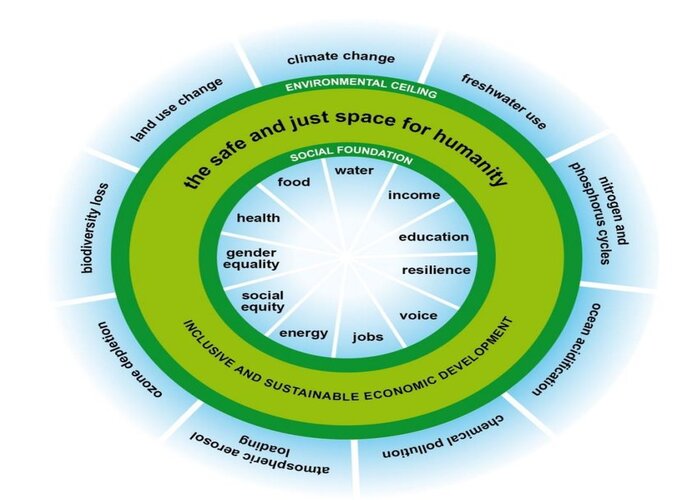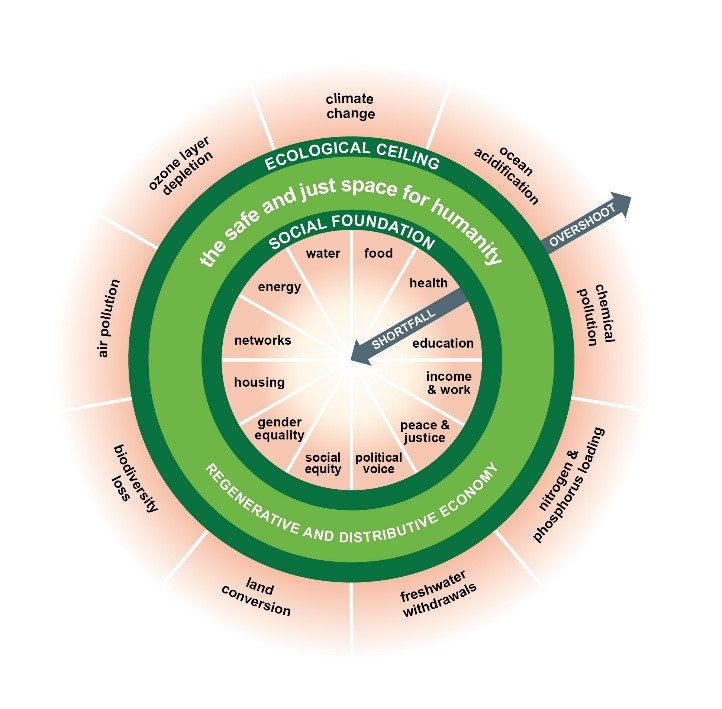Doughnut Economics

After World War II, the models for assessing the global economy began utilizing GDP as the ultimate measurement of national success, favouring economic output over all else. Many could point out that GDP was only measuring output and missed fundamental issues like inequality, environmental collapse, and people's overall health. Use of GDP as the primary measure of a nation's successfulness coincided with a world facing a series of crises where reliance on economic growth alone couldn't guarantee sustainability or justice as climate change, resource depletion, and escalating social inequality converged.
Many of the economic models based upon classical and neoclassical economics that came into power during this time characterize the environment as an "externality" in the calculation of wealth generation, and assume only rational, self-interested, and calculating human actors. If these views of the world were not static enough for the analysis of the 21st-century, economist Kate Raworth framed her model of Doughnut Economics with the realization that reliance on these contested and static concepts may not serve rational decision-making in all cases, and if they ever did, history shows they do not serve us well now. Doughnut Economics was first discussed in an Oxfam paper in 2012, and later in 2017 by Raworth in her book “Doughnut Economics: Seven Ways to Think Like a 21st Century Economist.”
Raworth's model seeks to redefine economics through the dual lens of ecological sustainability and social equity. The concept is visually depicted below, as a doughnut:

Image Reference : https://en.wikipedia.org/wiki/Doughnut_%28economic_model%29
https://earth.org/what-is-doughnut-economics/
- The inner ring represents the social foundation made up of essentials such as food, water, shelter, health, education, income, and political voice. Falling below the social foundation means being in a state of poverty or human deprivation.
- The outer ring represents the ecological ceiling, reliant on planetary boundaries established by scientists. Ecological ceilings include basic limitations for climate stability, biodiversity, and clean air, which if crossed can increase environmental harm.
The area between the two rings establishes a "safe and just space for humanity," where every person and their needs are substantiated without breaking through Earth’s ecological ceiling.
As a result, Doughnut Economics offers a holistic, but transformative "Economics" that presents a departure from growth obsession, and proposes a regenerative and distributive economy for people and the planet.
Reference : https://doughnuteconomics.org/about-doughnut-economics
Raworth, K. (2017). Doughnut Economics: Seven Ways to Think Like a 21st-Century Economist. United Kingdom: Chelsea Green Publishing.
Written by,
Ms. Piyusha
Assistant professor, Presidency School of Commerce













 Rajanukunte, Yelahanka, Bengaluru, Karnataka, Pin: 560119, India
Rajanukunte, Yelahanka, Bengaluru, Karnataka, Pin: 560119, India
 +91 9022092222
+91 9022092222